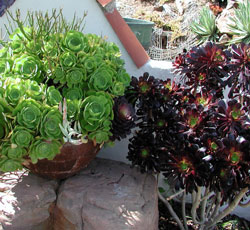Resource Library
Plant of the Week: Black Tree Aeonium
The University of Arkansas System Division of Agriculture does not promote, support or recommend plants featured in "Plant of the Week." Please consult your local Extension office for plants suitable for your region.
Plant of the Week
[A-Z]
Black Tree Aeonium
Latin: Aeonium arboreum 'Zwartkop'

Marketing - or more properly selling - is the name of the game in our capitalist society. If you've been by your favorite purveyor of plants, you've probably seen an offering of unusual succulents packaged just for Dad.
Dads are less likely to be interested in a potted geranium or a hanging basket, but show them an oddball succulent and you might get their attention. One of the plants offered late for this holiday is the black tree Aeonium (Aeonium arboreum 'Zwartkop').
The black tree Aeonium belongs to the crassula (stonecrop) family and has the general look of a "hens-and-chicks (Sempervivum)," except the tree Aeonium produces its succulent, plate-like rosettes on stilts. The stems, which usually branch near the base, are thumb-sized with the 6-inch diameter black, fleshy rosettes at the end of the branches. In coastal areas of Southern California where tree Aeonium can be grown outside, it will reach 3 feet in height. In pots, it seldom exceeds half that.
Flowering, something usually considered undesirable, occurs only on mature plants during the late spring in the greenhouse or in the summer in areas where it can be grown out of doors. The small star-shaped yellow flowers are borne in a large terminal panicle at the ends of the stems. But whenever a rosette blooms, that stem dies.
Thirty-five species of Aeonium have been described with most native to North Africa (especially Morocco) and adjacent offshore Atlantic islands. A. arboreum is native to the Canary Islands, where they inhabit desert areas.
The black tree Aeonium was a Dutch cultivar (some sources say German) grown from seeds collected from a wild, dark-leafed form. The cultivar name means "black head" in Dutch. The same plant is sometimes offered under the cultivar name "Schwartzkopf," which means "black head" in German. The first introduction of the plant to the United States was through the Berkley Botanical Garden; the plant has been produced by west coast growers since the early 1980's.
Aeonium should be potted in a well-drained potting medium that is kept moderately moist, but never wet, during the growing season. In its native haunts, it is summer-dormant, so be careful not to overwater. Plants are not heavy feeders, so fertilize no more than two or three times during the summer growing season. It will grow in full sun during the cooler parts of the year, but as July and August approach, relocate the pot to an area receiving afternoon shade. It has no frost tolerance, so move it indoors before the first frost.
During the winter, give it 50 degrees Fahrenheit temperatures at night, and keep it dry - watering only about once a month to keep the leaves from shriveling. Propagation is easy by means of cutting off the terminal rosette in late winter. Stick this rosette at the base of the original plant, and it will soon root. The old cut stub will produce side shoots and grow a new top. Periodically, re-propagating in this fashion keeps the plant from flowering. Like most other members of the crassula family, it can be propagated from leaf cuttings.
By: Gerald Klingaman, retired
Extension Horticulturist - Ornamentals
Extension News - June 27, 2008
The University of Arkansas System Division of Agriculture does not maintain lists of retail outlets where these plants can be purchased. Please check your local nursery or other retail outlets to ask about the availability of these plants for your growing area.